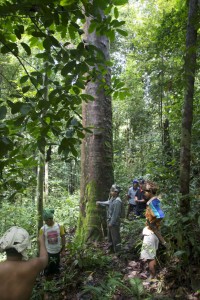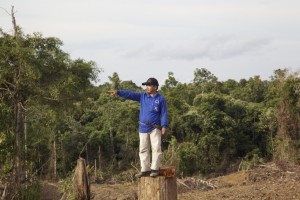‘That’s my river you’ve taken! Go away, this is our land!’


“If you walk down through the forest, you will walk past our nursery and then you will see the river. You can take a bath there and we can eat dinner afterwards,” said Pak Asuy, a village elder of Muara Tae.

Asuy, Masrani, Singko, Sedan, leaders of Indigenous Peoples of Muara Tae formed a ceremony to invoke the spirit of the ulin tree to protect their forests (credit: EIA/Tom Johnson)
Deep in the interior of East Kalimantan, we were there to meet up with our partner Telapak and to find out from the Dayak tribe what was happening to their land, forest and community. You’re going to hear a lot about Maura Tae, because it represents everything in Indonesia that is right and wrong, and more than anything it is a community literally fighting for its existence.
When we first arrived in the village, I really didn’t know what to expect. Telapak has been alongside the community for 14 years, supporting its struggle against a huge mining concession which started in the 1970s and has carved out a massive part of its land. The neighbouring community had sold its land to palm oil companies and the clearance of that forest is now starting on the land of Maura Tae, whose people don’t want to sell and who are desperately looking to the head of the district to stop the company from clearing anymore of their forest.
We walked from the village deep into the forest to stay with some of the elders and to find out more. In all the years I have worked with EIA, I have never seen anything as beautiful as the forests of Maura Tae – while the 8km walk was hard, it didn’t matter; with wild fruit trees from which we ate from along the way and sounds of the proboscis monkey in the trees, the humming of bees and songs of the birds, I started to feel a deep emotion towards this land.

Inside the Telapak/Muara Tae guard post at night (credit: EIA/Tom Johnson)
We arrived at a post which had been built by Telapak and the community (a sort of long house without walls, and plastic sheeting for a roof) to find some of the elders sitting around chatting. It was a wonderful evening and we learnt so much, not just about the fight to save their land but their culture and their beliefs in the spirit of the forest, how over the years they have planted new trees and have grown their own medicinal plants. To stay on this land means the forest will grow. Pak Asuy started playing a sort of homemade xylophone, beating out the notes while Pak Singko danced around us. We were enveloped by their warmth and openness to complete strangers.
The week we spent there gave us an opportunity to see how the solution to Indonesia’s challenge to combat deforestation lies with its indigenous communities. Pak Asuy and Pak Singko explained that if they lose this forest, they will die – they have nowhere to go, they live completely sustainably from the forest, their water, their food and the futures of their children all depend on this land.

Masrani stands on an Ulin stump in the Dayak Benuaq’s customary land, cleared by palm oil firm PT Munte Wani Jaya Perkasa last year (credit: EIA/Tom Johnson)
The elders took us to see where the plantation company had started to clear into Maura Tae in October last year. With 200 hectares already taken, I stood on a dirt road with the forests of Maura Tae to my left and devastated land to my right; the huge Ulin trees that reach for the sky lying dead on the ground, a bulldozer behind me scooping up logs and dropping them as though they were bodies on a funeral pile. As the bulldozer went down and into what was once a river, Pak Singko started shouting at it “That’s my river you’ve taken! Go away, this is our land!”. It broke my heart to hear the pain in his voice.
The answers to tackling climate change are here right in front of us, in the communities around the country. It’s completely insane to rely on the

EIA Forest Campaign team leader Faith Doherty interviewing Muara Tae elders (credit: EIA/Tom Johnson)
‘development’ of plantations and to think that they offer anything but disaster for local communities who are being thrown to the wolves. Saving Maura Tae is preventing poverty, something the forests have been doing for hundreds of years. If they lose their land, they will end up scattered and with no livelihoods. The sustainable methods used over generations have shown that this is the way to ensure forests remain intact.
We were staying at the house of Pak Asuy and his son, their wives and beautiful children, the latest baby, Padre, curled up in my lap fast asleep. What will be his future? Will he, like his father, have to fight to keep his land or will they be able to stop this happening?
I believe they can, we all believe they can, and EIA and Telapak are going to be with them all the way. We are definitely no longer strangers.